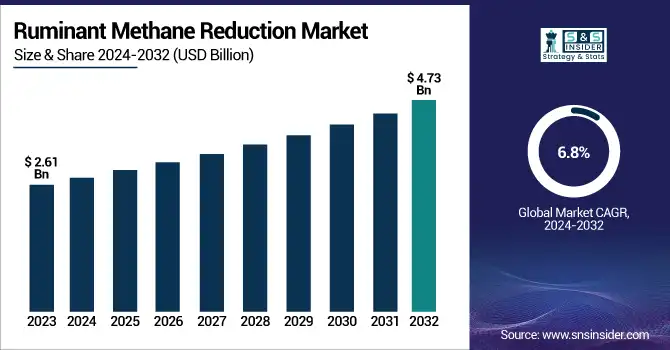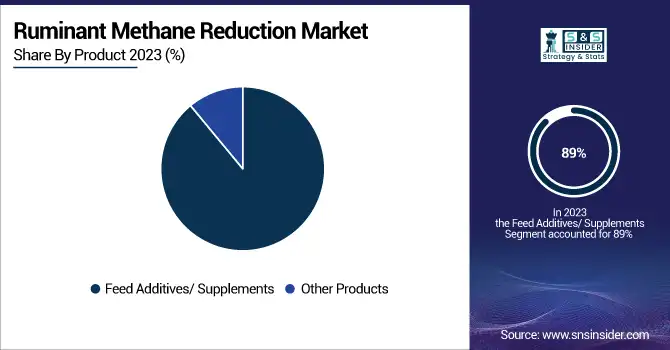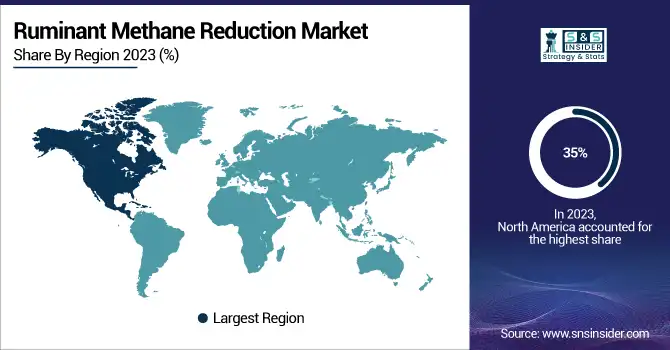Ruminant Methane Reduction Market Size Analysis:
The Ruminant Methane Reduction Market Size was valued at USD 2.61 Billion in 2023 and is expected to reach USD 4.73 billion by 2032, growing at a CAGR of 6.8% over the forecast period 2024-2032.
This report covers major statistical insights and trends in the Ruminant Methane Reduction Market regarding the growth of the industry, adoption, and regulatory impact. It includes targets for methane emissions reduction and the progress made in achieving them. Methane emissions from livestock are analyzed by region and farm size, along with adoption rates of methane-reducing solutions, such as feed additives and vaccines. The market volume of these technologies is further explored, along with investment and funding trends. The report also details regulatory policies that cut methane and its economic benefits. The solution cost-benefit analysis looks at the environmental and financial implications of these solutions in order to capture a view of the industry's potential future direction.

To Get more information on Ruminant Methane Reduction Market - Request Free Sample Report
Growing environmental concerns and government initiatives to reduce greenhouse gas emissions are the main drivers of the ruminant methane reduction market. Ruminant methane emissions represent close to 14.5% of global greenhouse gas emissions, highlighting its importance in climate initiatives. In 2023, the U.S. held a leading share of 33% of the global ruminant methane reduction market and 89% of the North American ruminant methane reduction market with government programs such as the Methane Emissions Reduction Action Plan under the Inflation Reduction Act incentivizing sustainable livestock practices. The U.S. Department of Agriculture reported there were 87.8 million cattle in the United States as of January 2024, highlighting the major opportunity for methane mitigation strategies.
Ruminant Methane Reduction Market Dynamics
Drivers
-
Stricter environmental regulations, such as the EU’s "Farm to Fork" strategy, are driving the adoption of methane-reducing solutions in livestock farming.
The European Union’s “Farm to Fork” strategy, represents a major global effort to increase the sustainability of food systems, one aspect of which is the reduction of methane emissions from livestock. This effort comes amid growing calls to tackle methane's role in climate change, with human activity responsible for at least two-thirds of the world's methane emissions, a 20% increase in two decades and the fastest increase occurring in the last five years. Agriculture, and livestock farming in particular, is a major source of these emissions. The largest 5 anthropogenic methane emitters in 2022 were China (16%), India (9%), the USA (7%), Brazil (6%), and Russia (5%) of which large fractions were from livestock activities.
In response, innovative solutions are being implemented. For example, Dutch company DSM-Firmenich has created Bovaer, a feed additive that can cut methane emissions from dairy cows on average by 30% and up to 45% for beef cattle. The U.S. Food and Drug Administration approved Bovaer for the U.S. market in May 2024 and a new facility in Scotland is estimated to produce enough of the additive to treat 4 to 5 million cows each year starting in 2025. Breeding strategies are also being considered. In Scotland, researchers have been using in vitro fertilization (IVF) to speed up the breeding process of calves like Hilda, with the goal of producing cows that emit less methane. This could cut the two-year maturation period in half, stepping up the availability of low-emission beef. This reflects the global commitment to addressing methane emissions, particularly in agriculture, leading to the adoption of many new technologies and innovations for sustainable livestock practices.
Restraint
-
High costs of feed additives and limited awareness among small-scale farmers hinder widespread adoption.
The adoption of methane-reducing feed additives in the ruminant livestock sector faces significant challenges, primarily due to high costs and limited awareness among small-scale farmers. For instance, incorporating the additive 3-Nitrooxypropanol (3-NOP) into dairy cattle feed can cost between €62 and €110 per cow annually, depending on dosage. This translates to an additional expense of approximately 2.5 cents per liter of milk, representing about 13% of a farmer's annual income. Similarly, the additive Bovaer costs around 1 cent per liter of milk, adding to production costs without corresponding financial incentives from major companies committed to reducing emissions.
These added costs are particularly burdensome for small-scale farmers, who often operate with limited financial margins. The lack of premiums for low-emission products further discourages investment in such additives. Additionally, there is a prevalent lack of awareness and technical knowledge regarding sustainable practices among these farmers. In regions like Colombia, the adoption of sustainable systems such as silvopastoral systems remains limited due to high upfront costs and technical knowledge gaps. This combination of financial constraints and informational barriers hampers the widespread implementation of methane-reducing strategies in the ruminant livestock sector.
Opportunity
-
Innovations like Asparagopsis taxiformis (seaweed-based feed additive) can reduce methane emissions by up to 80%, creating growth opportunities.
Feeding additives such as Asparagopsis taxiformis represent a major opportunity for reducing methane emissions in cattle. Research shows that adding this red seaweed to the diet of cattle can reduce their methane production by 99% to 33%. As one recent study published in the Proceedings of the National Academy of Sciences this past December found, feeding grazing beef cattle a seaweed supplement reduced methane emissions by almost 40% without any adverse effects on the animals’ health or weight. Further emphasizing the potential of Asparagopsis taxiformis, a study published in Animal Feed Science and Technology in October 2024 revealed that whole dried Asparagopsis seaweed reduced methane emissions by 95.6% when included at 0.5% of the diet. This reduction was significantly greater than the 59.6% decrease observed with an equivalent dose of bromoform alone, suggesting that other bioactive compounds in the seaweed contribute to its methane-reducing effects.
Australian scientists have also discovered a natural feed additive from native Curvularia soil fungi that can cut methane emissions from cattle and sheep by up to 90% and alternatives to grazing animals. Like Asparagopsis, this additive also produces bromoform, providing a different strategy for mitigating livestock methane. Such innovations not only offer powerful solutions for mitigating greenhouse gas emissions from livestock but also create new possibilities for sustainable approaches to agriculture. Such feed-additive technologies, once developed and commercialized, could help advance the world’s strategies for tackling climate change while also aligning with the economic interests of farmers and ranchers alike.
Challenge
-
The presence of multiple methane reduction strategies creates intense market competition, limiting dominance by any single solution.
The ruminant methane reduction market is expected to be challenging due to the large variety of mitigation strategies available as well as a high number of competitive solution providers. The livestock sector is working to reduce methane emissions using several methods, including feed additives, changes to diets, and manure management practices. This plurality of solutions leads to a fragmented landscape, as no one method has become the overwhelming standard. For example, feed additives such as Bovaer have shown the ability to cut methane emissions by around 30% in dairy cows and 45% in beef cattle. However, not all companies are using such additives, in part because of competition from alternative techniques and products. Furthermore, misinformation and public distrust could prevent the acceptance of some technologies. One of the prominent cases is for Bovaer, developed by Arla Foods UK; even with approvals and safety validated by science, was met with consumer resistance based on questions that have no basis in science. It highlights the challenges that businesses encounter in presenting their unique solutions in a field that is both crowded and competitive. As a result, the existence of numerous mitigation approaches, along with differing levels of acceptance and comprehension, presents a significant challenge for stakeholders seeking to implement feasible and broadly accepted solutions for methane reduction in the ruminant agriculture sector.
Ruminant Methane Reduction Market Segmentation Analysis
By Product
In 2023, feed additives and supplements held the largest share of the product segment of the ruminant methane reduction market, accounting for more than 89% of global revenue. This dominance can be explained by their demonstrated effectiveness at directly reducing methane emissions from the rumen digestion process. Plant-based compounds, chemical inhibitors (such as nitrate-based supplements), and microbial formulations are among the feed additives that are most commonly recommended for antimutagenic purposes owing to their potential for decreasing methanogenesis in the rumen without harming livestock health or productivity. Such growth has been aided by government initiatives. For instance, the U.S. Inflation Reduction Act offers subsidies to farmers who adopt feed technologies to reduce methane emissions. In the same vein, Europe’s Green Deal promotes sustainable feed solutions with financial incentives and strict compliance needs. Innovative feed additives, according to the Food and Agriculture Organization (FAO), could lower these emissions by up to 30%, driving even more adoption.
Technological advancements have enhanced the efficiency and cost-effectiveness of these products. Companies like DSM and Cargill, are investing huge amounts in R&D into developing next-generation feed additives that are effective but also affordable for small-scale farmers. For example, DSM’s Bovaer has demonstrated a reduction in methane emissions of as much as 80% when introduced into cattle’s diet. A major contributor to this is the increasing livestock population worldwide. India alone had more than 307 million heads of bovine livestock in 2023, according to FAO statistics, generating sufficient demand for feed additives designed to reduce emissions from such large herds.

By Animal
The cattle segment had the highest revenue of 81% in 2023 due in part to their substantial contribution to global emissions of methane emissions from enteric fermentation. Cattle have been a key target for mitigation strategies around the world as one of the largest sources of agricultural greenhouse gases. American society, where the most recent update from its Department of Agriculture in January 2024 reported that the cattle population was 87.8 million, is not an exception. Governments have prioritized cattle-focused initiatives because of their disproportionate effect on emissions. For example, Australia’s National Livestock Methane Program has supported research on reducing methane from beef and dairy cattle through dietary modifications and genetic selection. Similarly, Europe’s Common Agricultural Policy incentivizes farmers to adopt low-emission practices specifically targeting cattle.
The goats segment is anticipated to account for the highest CAGR over the forecast period. Its strong growth is due to increasing goat farming activities in areas like Asia-pacific and Africa, as these animals are highly adaptable and economically significant in smallholder systems. Goats have been growing steadily in these regions, according to FAO data from prior years, as they are crucial for livelihoods while using fewer resources than cattle. Advancements in technology targeted at smaller ruminants are also driving growth in this segment. Now, innovations, like targeted feed additives for goats, are coming to the fore as governments broaden methane reduction initiatives beyond cattle.
Regional Insights
In 2023, North America led the ruminant methane reduction market, accounted for 35% of the global market share. This leadership is due to significant government investments and incentives to curb methane emissions from livestock. One example is the U.S. Department of Agriculture (USDA), which announced in December 2023 the release of $10 million from its National Institute of Food and Agriculture to fund interdisciplinary research on methane mitigation. Initiatives like the U.S. Methane Emissions Reduction Action Plan via the Inflation Reduction Act, which incentivize livestock producers to implement advanced technologies and practices such as feed additives and precision farming techniques to reduce methane emissions. Its dominance is bolstered by the presence of numerous major players in the region and advanced manufacturing capabilities.
The Asia-Pacific region is expected to be the fastest-growing region in terms of compound annual growth rate (CAGR) throughout the forecast period. The growth has been driven by rising emissions from the rapidly growing livestock sector in the region, which is responsible for a large share of global methane emissions. On the other hand, countries such as India and China are prominent contributors, with India being home to over 307 million bovine animals in 2023, as recorded by the Food and Agriculture Organisation (FAO). These countries are starting to practice more sustainable agriculture, and are working with global organizations that help peg them to disseminate methane-reducing technologies. For example, India has formed partnerships with global agencies to promote feed additives that reduce methane production.

Get Customized Report as per Your Business Requirement - Enquiry Now
Ruminant Methane Reduction Market Key Players
Key Service Providers/Manufacturers
-
DSM-Firmenich (Netherlands)
-
Cargill, Incorporated (USA)
-
Alltech (USA)
-
Elanco Animal Health Inc. (USA)
-
CH4 Global, Inc. (Australia)
-
Rumin8 Ltd (Australia)
-
Mootral (UK)
-
Symbrosia Inc. (USA)
-
Blue Ocean Barns (USA)
-
Zelp Ltd (UK)
-
FutureFeed (Australia)
-
Fonterra Co-operative Group Limited (New Zealand)
-
AgResearch (New Zealand)
-
BASF (Germany)
-
Novus International (USA)
-
Adisseo (France)
-
Nutreco (Netherlands)
-
Provimi (Netherlands)
-
Phibro Animal Health Corporation (USA)
-
Evonik Industries (Germany)
Recent Developments in the Ruminant Methane Reduction Market
-
In June 2024, DSM announced it would be launching an advanced version of its Bovaer feed additive that is more efficient.
-
In July 2024, Cargill invested $1 million in Colorado State University's AgNext research program. This funding supports studies on sustainable animal agriculture practices, focusing on reducing enteric methane emissions from feedlot cattle through various feeding strategies.
| Report Attributes | Details |
|---|---|
| Market Size in 2023 | USD 2.6 Billion |
| Market Size by 2032 | USD 4.7 Million |
| CAGR | CAGR of 6.8% From 2024 to 2032 |
| Base Year | 2023 |
| Forecast Period | 2024-2032 |
| Historical Data | 2020-2022 |
| Report Scope & Coverage | Market Size, Segments Analysis, Competitive Landscape, Regional Analysis, DROC & SWOT Analysis, Forecast Outlook |
| Key Segments | • By Product (Feed Additives/ Supplements {Plant-based, Chemical-based, Microbial-based}, Other Products) • By Animal Type (Cattle, Goats, Sheep) |
| Regional Analysis/Coverage | North America (US, Canada, Mexico), Europe (Eastern Europe [Poland, Romania, Hungary, Turkey, Rest of Eastern Europe] Western Europe] Germany, France, UK, Italy, Spain, Netherlands, Switzerland, Austria, Rest of Western Europe]), Asia Pacific (China, India, Japan, South Korea, Vietnam, Singapore, Australia, Rest of Asia Pacific), Middle East & Africa (Middle East [UAE, Egypt, Saudi Arabia, Qatar, Rest of Middle East], Africa [Nigeria, South Africa, Rest of Africa], Latin America (Brazil, Argentina, Colombia, Rest of Latin America) |
| Company Profiles | DSM-Firmenich, Cargill, Incorporated, Alltech, Elanco Animal Health Inc., CH4 Global, Inc., Rumin8 Ltd, Mootral, Symbrosia Inc., Blue Ocean Barns, Zelp Ltd, FutureFeed, Fonterra Co-operative Group Limited, AgResearch, BASF, Novus International, Adisseo, Nutreco, Provimi, Phibro Animal Health Corporation, Evonik Industries. |

